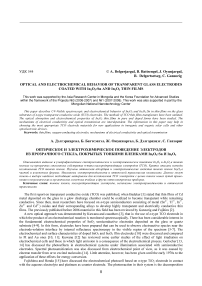Optical and electrochemical behavior of transparent glass electrodes coated with In 2O 3:Sn and In 2O 3 thin films
Автор: Delgerjargal A., Battsengel B., Oyunjargal J., Delgertsetseg B., Ganzorig C.
Журнал: Вестник Бурятского государственного университета. Философия @vestnik-bsu
Рубрика: Химия
Статья в выпуске: 3, 2014 года.
Бесплатный доступ
This paper describes UV-Visible spectroscopic and electrochemical behavior of In 2O 3 and In 2O 3:Sn in thin films on the glass substrates of n-type transparent conductive oxide (TCP) electrodes. The methods of TCP thin films manufacture have been outlined. The optical absorption and electrochemical properties of In 2O 3 thin films in pure and doped forms have been studied. The mechanisms of electrical conductivity and optical transmission are interdependent. The information in this paper may help in choosing the most appropriate TCP electrode materials for new applications in inorganic and organic solar cells and other optoelectronic devices.
Thin films, oxygen-conducting electrodes, mechanisms of electrical conductivity and optical transmission
Короткий адрес: https://sciup.org/148182399
IDR: 148182399 | УДК: 544
Текст научной статьи Optical and electrochemical behavior of transparent glass electrodes coated with In 2O 3:Sn and In 2O 3 thin films
The first report on transparent conductive oxide (TCO) was published, when Badeker [1] stated that thin films of Cd metal deposited on the glass in a glow discharge chamber could be oxidized to become transparent while remaining conductive. Since then, most researchers have focused on n -type semiconductors consisting of metal (Sn4+, Ti2+, In3+, Zn2+ and Cd2+) oxides and their corresponding alloys to develop highly transparent and electrically conductive thin films. The previously published before 2006 material in this field has been reviewed by Ganzorig and Fujihira [2].
A new optical approach was demonstrated by Kuwana and coauthors [3], that is: the use of n -type TCO electrode in which the product of an electrochemical reaction is monitored spectroscopically. There has been considerable interest in the fundamental electrochemical properties of SnO2 semiconductive electrodes deposited on the glass or quartz substrate [4-9]. In this form, electrodes have been prepared that can be used to observe electroactive species near the electrode-solution interface by internal reflectance spectroscopy in the visible region of the spectrum [5-7]. The electrochemical and surface characteristics of doped SnO 2 and In 2 O 3 film electrodes [10] were discussed and compared to Pt and Au ones [10, 11]. Kuwana [12] has reviewed some earlier studies of the effect of light irradiation on electrochemical cells and those in which light emission is a consequence of the electrochemical process. Gerischer [13, 14] has discussed the photoeffects in electrochemical systems under illumination associated with semiconductive electrodes. Spectral photosensitization was also discussed from electrochemical point of view, as it was caused by electron transfer from or to excited molecules [14]. Little attention, however, has been given until the early 1970s to the application of these effects for energy conversion.
Fujishima and Honda [15] have discussed the electrochemical photocell based on n-type TiO2 electrode in contact with the aqueous electrolyte and platinum as counter electrode. The photoreaction in their system is the decomposition of water due to the oxygen evolution at the irradiated TiO2 electrode and hydrogen evolution at the Pt electrode. Unfortunately, TiO2 has a low quantum yield for the photochemical conversion of solar energy. High-surface-area TiO2 films deposited on the conductive glass sheet from colloidal suspensions were reported by O’Regan and Gratzel [16]. The use of these films with the addition of dye molecules has been shown to improve solar cells [16].
Most of the useful TCOs with a wide bandgap (≥3 eV) studied until nowadays have been chemically inert conductive oxides, such as TiO 2 [17], SnO 2 [18], In 2 O 3 [19, 20] and ZnO [13]. The bandgaps of these n -type semiconductors correspond to the energy photons in the UV region. Schematic band diagram of these oxides [2] is shown in Fig. 1. Solar energy reaching the Earth surface has, however, spectrum distribution in the longer wavelength range and cannot, therefore, be used effectively by these electrodes [21]. Spectral sensitization would solve this problem. Osa and Fujihira [22] have developed a new type of electrochemical photocell, using a TCO electrode which surface was modified by the chemical binding of sensitizing dyes. The solar cells developed by Gratzel and his colleagues [16] described above are in this category.
The material properties of In2O3 are generally characterized by the high optical transparency for visible light and the high electrical conductivity [23]. To increase the conductivity of In2O3 , it is generally doped with Sn and further known as ITO (or In2O 3 :Sn). The conductivity of ITO films can be as high as 0.5-1.0 x 10 4 S/cm. In ITO films, the electron concentration of ITO is ~1021 cm-3 [23], with optical transparency still existing. Such unique characteristics have led to the exclusive utilization of ITO films in flat-panel displays and solar cells.
Vacuum level
~
TiO2 CB
SnO2
In2O3
ZnO
3.2 eV
3.4 eV
3.8 eV
3.75 eV
VB
Fig. 1. Schematic diagram illustrating energy levels of conduction band (CB) and valence band (VB) of some n -type undoped semiconductive oxides TiO 2 [17], SnO 2 [18], In 2 O 3 [19, 20] and ZnO [13]
The electrical, optical, and chemical properties as well as physical properties of TCO materials can be controlled by altering their chemical compositions [24]. The physical properties shown in Table are the bandgap energy and work function for various types of pure and doped TCO semiconductors [2]. Bandgap widening associated with doping has been observed in earlier work on doped In2O3 films [23].
The optical data [23] indicated that a gradual shift of the band gap to warded higher energy as the electron density was increased. Values for the work function ( ^ b ) are defined, as the minimum energy required for an electron to escape into vacuum from the Fermi level. The work function of TCO electrodes can be controlled after chemical modification [2]. The work function of TCO electrode surfaces also depend upon cleaning method.
Useful descriptions of the most widely used preparative deposition techniques for thin films of TCO electrodes were presented in detail [2]. To investigate the optical and electrochemical TCO electrodes, we report here the use of In 2 O 3 and In 2 O 3 :Sn thin films prepared on the glass substrate to measure the absorption in the UV and visible regions and the electrochemical conductivity behavior of these TCO electrodes studied.
Table
Bandgap energy and work function for some n -type transparent conductive pure or doped semiconductive oxides
|
Material |
Bandgap (eV) |
Work function (eV) |
|
SnO 2 |
3.8 |
4.7 |
|
SnO 2 :F |
4.4 |
|
|
In 2 O 3 |
3.75 |
4.4 ± 0.1 |
|
In 2 O 3 :Sn |
3.8 - 4.5 |
4.4 - 4.8 |
|
ZnO |
3.4 |
4.3 |
|
ZnO:F |
4.2 |
|
|
ZnO:Al |
3.9 |
4.4 |
|
TiO 2 |
3.0 - 3.2 |
4.2 - 4.3 |
|
SrTiO 3 |
3.4 |
4.0 |
Experimental details
ITO coated glass (Sanyo Vacuum Industries) and quartz substrates were cut into 15 x 20 mm2 stripes. The substrates were cleaned and rinsed by sonication successively in two detergents (Extran MA 03, pH 6.8, MERCK and Kontaminon O, pH 10, WAKO) and distilled water and were stored under ethanol until being required. Prior to use, the substrates were further cleaned and ultrasonicated successively in acetone and ethanol, and then were transferred to boiled ethanol.
In2O 3 coated glass was made by the vacuum evaporation process under the pressure of ~5-7 x 10-6 Torr, (Fig. 2). To study optical properties of ITO and In2O3 the absorption spectral data for all the thin films were taken using an UV-visible spectrophotometer (UV-265FW, Shimadzu) at room temperature in ambient atmosphere.
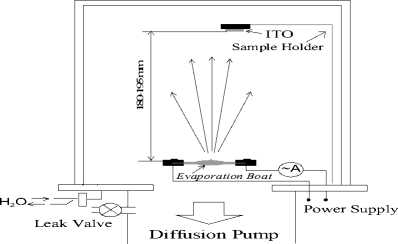
Fig. 2. Vacuum deposition system
To study PV properties, the ITO (160 nm)/KCl (0.5M)/Pt and In 2 O 3 (60 nm) KCl (0.5M)/Pt cells were prepared. The current density-voltage ( J-V ) curves were measured under the sun light conditions. Electric data were taken with a hand-made voltage current source unit.
Results and discussion
To study the optical and electrochemical behaviour of transparent glass electrodes coated with the thin films of ITO and In 2 O 3 -inorganic semiconductor, we compared its absorption and transmittance properties with glass substrates. Transmittance of glass along the whole wavelength is 100%, so that glass can not cut poisonous ray. Fig. 3 shows the wavelength dependence on the optical transparency of 200-900 nm range.
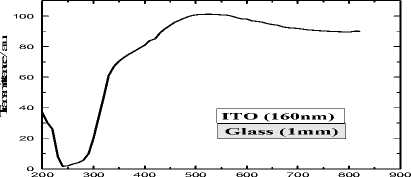
Fig. 3. Transmittance of ITO-electrodes
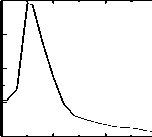
ITO (160 nm)
Glass (1mm)
200 300 400 500 600 700 800
Wavelength / nm
Fig. 4. Absorption spectrum of ITO-electrode
ITO electrode has full transmittance in visible wavelength range and no transmittance in UV (200-300nm), that allows wide practical use. Absorption spectrum of ITO –electrodes on glass was shown in Fig. 4.
We have recorded the UV-visible absorption spectra and transmittance of In2O3 on glass, (Fig. 5 and Fig.6). In visible range ITO as well as In2O3 have shown high transparency.
In Fig.7, the transmittance of ITO and In 2 O 3 is compared with glass. ITO has significantly higher absorption and broader wavelength range compared to In 2 O 3 in the visible wavelength range. Electrochemical properties of ITO electrode were measured by the current density-voltage ( J-V bias ) characteristics.
Electron displacement from ITO electrodes to electrolyte solution has high barrier to overcome and current density amounts to zero value at voltage lower 1.3 V (Fig. 8). From this point the current density increases significantly. This indicates ITO can be used as a semiconductor. Besides conductive properties of In 2 O 3 deposited on the glass were measured. As is shown in Fig.9. In 2 Î has wider bandgap than ITO that let electrons move into electrolyte solution easier. This electrode obeys Ohm Law.
0b
200 300
400 500
Wavelength / nm
In2O3 (60nm)
Glass (1mm)
600 700 800 900
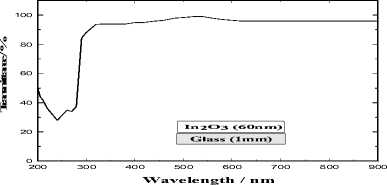
Fig. 6. Transmittance of In 2 O 3 -electrodes
Fig. 5. Absorption spectrum of In 2 O 3 -electrode
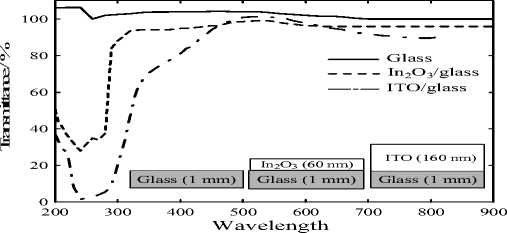
Fig. 7. Transmittance of ITO and In 2 O 3 compared with glass

ITO, In2O3 электрод

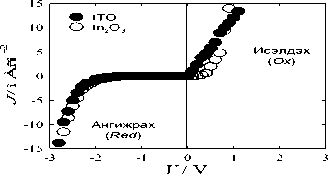
Fig. 8. Current density-voltage behavior of electrical conduction for ITO, In 2 O 3 electrodes in 0.5 M KCl solution

LUMO ( Ox )
In2O3
ITO
e -
HOMO ( Red )
0.01


V / V
Conclusion
In this study, we have described the UV-Visible spectroscopic and electrochemical behavior of In 2 O 3 and In 2 O 3 :Sn thin films on the glass substrates. The optical absorption and electrochemical properties of In 2 O 3 thin films in pure and doped forms have been studied. Further studies on the preparation and characterization of TCO electrodes such as In 2 O 3 and ITO will be expanding our understanding and advancement of the science and applications of inorganic and organic optoelectronic materials and devices.
Список литературы Optical and electrochemical behavior of transparent glass electrodes coated with In 2O 3:Sn and In 2O 3 thin films
- Badeker K. Uber die elektrische Leitfahigkeit und die thermoelektrische Kraft einiger Schwermetallverbindungen//Ann. Physik. -1907. -V. 22. -P. 749-766.
- Chen X. et al. Synthesis and characterization of two alkali -metal zinc borates, a -LiZnBO3 and Li0,48Na0,52ZnBO3//S. State Sciences. -2009. -V. 11. -P. 2086-2092.
- Ganzorig C., Fujihira M. Chemically Modified Oxide Electrodes, Modified Electrodes//Encyclopedia of Electrochemistry. -2007. -V. 10. -P. 261-344.
- Strojek J.W., Kuwana T. Electrochemical-spectroscopy using tin oxide-coated optically transparent electrodes//Electroanal. Chem. -1968. -V. 16. -P. 471-483.
- Srinivasan V.S., Kuwana T. Internal reflection spectroscopy at optically transparent electrodes//J. Phys. Chem. -1968. -V. 72. -P. 1144-1148.
- Osa T., Kuwana T. Nonaqueous electrochemistry using optically transparent electrodes//J. Electroanal. Chem. -1969. -V. 22. -P. 389-406.
- Winograd N., Kuwana T. Characteristics of the electrode-solution interface under faradaic and non-faradaic conditions as observed by internal reflection spectroscopy//J. Electroanal. Chem. -1969. -V. 23. -P. 333-342.
- Laitinen H.A., Vincent C.A., Bednarski T.M. Behavior of Tin Oxide Semiconducting Electrodes Under Conditions of Linear Potential Scan//J. Electeroanal. Soc. -1968. -V. 115. -P. 1024-1028.
- Elliott D., Zellmer D.L., Laitinen H.A. Electrochemical Properties of Polycrystalline Tin Oxide//J. Electrochem. Soc. -1970. -V. 117. -P. 1343-1348.
- Electrochemical and surface characteristics of tin oxide and indium oxide electrodes/N.A. Armstrong, A.W.C. Lin, M. Fujihira, T. Kuwana//Anal. Chem. -1976. -V. 48. -P. 741-750.
- Fujihira M., Kuwana T. Studies of Electrochemical interfaces of thin PT film electrodes by surface contuctans//Electrochim. -1975. -V. 20. -P. 565-573.
- Kuwana T. Electroanalytical Chemistry. -Marcel Dekker, New York. -1966. -V. 1. -P. 197-240.
- Gerischer H. Electrochemical behavior of semiconductors under illumination//J. Electrochem. Soc. -1966. -V. 113. -P. 1174-1182.
- Gerischer H. Electrochemical techniques for the study of photosensitization//Photochem. Photobiol. -1972. -V. 16. -P. 243-260.
- Fujishima A., Honda K. Electrochemical photolysis of water at a semiconductor electrode//Nature. -1972. -V. 238. -P. 37-38.
- O’Regan B., Gratzel M. A low-cost, high-efficiency solar cell based on dye sensitized colloidal TiO2 films//Nature. -1991. -V. 353. -P. 737-740.
- Cronemeyer D.C. Electrical and optical properties of rutile single crystals//Phys. Rev. -1952. -V. 87. -P. 876-886.
- Nagasawa M., Shionoya S. Temperature dependence of the fundamental optical absorption edge in stannic oxide//J. Phys. Soc. -1971. -V. 30. -P. 1118-1123.
- Weiher R.L., Ley R.P. Optical Properties of Indium Oxide//J. Appl. Phys. -1966. -V. 37. -P. 299-302.
- Lang O., Pettenkofer C., Sanchez-Royo J.F. and etc. Thin film growth and band lineup of In2O3 on the layered semiconductor InSe//J. Appl. Phys. -1999. -V. 86. -P. 5687-5691.
- Gerischer H. Electrochemical photo and solar cells: principles and some experiments//J. Electroanal. Chem. -1975. -V. 58. -P. 263-274.
- Osa T., Fujihira M. Photocell using covalently-bound dyeson semiconductor surfaces//Nature. -1976. -V. 264. -P. 349350.
- Hamberg I., Granqvist C.G. Evaporated Sn-doped In2O3 films: basic optical properties and applications to energy efficient windows//J. Appl. Phys. -1986. -V. 60. -P. 123-159.
- Minami T. New n-Type Transparent Conducting Oxides//MRS Bull. -2000. -V. 25. -P. 38-44.

